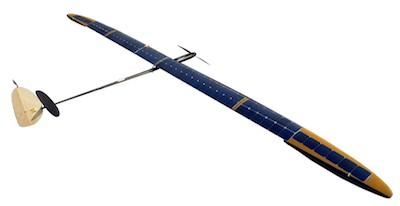Sat, Jul 21, 2018
Performed Monitoring And Aerial Photography During Daylight Hours
UAVOS Inc., a Mountain View, CA-based company specialized in unmanned solutions, has completed flight tests of the solar powered unmanned SAT-i aircraft, designed to perform monitoring and aerial photography during daylight hours. The new unmanned aircraft has demonstrated high performance, successfully completing a non-stop 10-hour mission for aerial photography of the surface landscape with a payload of a 21-ounce mirrorless camera.

SAT-i has a fixed wing with a wingspan of 24 feet. The weight of the aircraft is about 14 pounds. The UAV is equipped with a Li-Ion battery that allows flying without solar energy for 2 (optionally 4) hours with payload up to 1.3 pounds. The aircraft is hand-launched, the flight and landing are performed in fully autonomous mode. For UAV landing a flat level surface of 650 feet long is suitable, with a touchdown accuracy of about 328 feet. The landing trajectory calculations are carried out in an automatic mode taking into account the current weather conditions. Low landing speed of 7 m/s allows to keep the aircraft intact after numerous landings.
"Based on UAVOS experience, to achieve high quality aerial photography, work has to be done in the daytime with a good level of illumination. Using solar-powered aircraft for such missions is, in our opinion, most promising, since solar energy is sufficient to perform a continuous flight throughout the daylight hours," said Vadim Tarasov UAVOS investor and board member. "Especially effective is the use of such UAVs for high-resolution orthomosaic imagery in large areas with a long flight time. For example, to successfully solve communication problems during long-distance monitoring missions of electrical power lines UAVOS uses the Iridium data satellite transceiver module.”
The UAVOS SAT-i UAV technology offers cost-effective services for a wide range of customer needs, including prospecting, mapping, monitoring of important lines of communication in remote areas, while using only solar energy during the day. Backup batteries allow to perform short missions for 2-4 hours without solar activity, in case of need extending the operations.
(Image provided with UAVOS news release)
More News
Light Gun A handheld directional light signaling device which emits a brilliant narrow beam of white, green, or red light as selected by the tower controller. The color and type of>[...]
"The journey to this achievement started nearly a decade ago when a freshly commissioned Gentry, driven by a fascination with new technologies and a desire to contribute significan>[...]
Aero Linx: JAARS, Inc. For decades now, we’ve landed planes on narrow rivers and towering mountains. We’ve outfitted boats and vehicles to reach villages that rarely se>[...]
"Our driven and innovative team of military and civilian Airmen delivers combat power daily, ensuring our nation is ready today and tomorrow." Source: General Duke Richardson, AFMC>[...]
Aircraft Conflict Predicted conflict, within EDST of two aircraft, or between aircraft and airspace. A Red alert is used for conflicts when the predicted minimum separation is 5 na>[...]
 ANN's Daily Aero-Term (04.20.24): Light Gun
ANN's Daily Aero-Term (04.20.24): Light Gun Aero-News: Quote of the Day (04.20.24)
Aero-News: Quote of the Day (04.20.24) ANN's Daily Aero-Linx (04.21.24)
ANN's Daily Aero-Linx (04.21.24) Aero-News: Quote of the Day (04.21.24)
Aero-News: Quote of the Day (04.21.24) ANN's Daily Aero-Term (04.21.24): Aircraft Conflict
ANN's Daily Aero-Term (04.21.24): Aircraft Conflict



